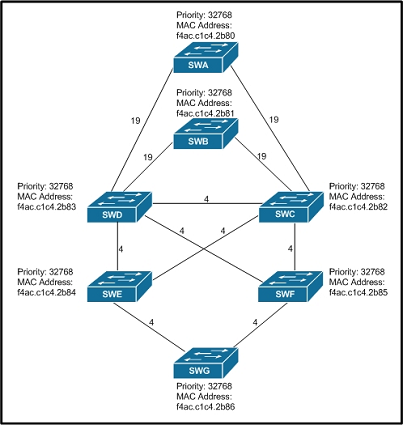READ Free Dumps For Cisco- 400-101
| Question ID 18610 | Refer to the exhibit.

All switches have default bridge priorities, and originate BPDUs with MAC addresses as
indicated. The numbers shown are STP link metrics.
After STP converges, you discover that traffic from switch SWG toward switch SWD takes
a less optimal path. What can you do to optimize the STP tree in this switched network?
|
| Option A | Change the priority of switch SWA to a lower value than the default value.
|
| Option B | Change the priority of switch SWB to a higher value than the default value.
|
| Option C | Change the priority of switch SWG to a higher value than the default value.
|
| Option D | Change the priority of switch SWD to a lower value than the default value.
|
| Correct Answer | D |
Explanation Explanation: In this topology, we see that all port paths and priorities are the same, so the lowest MAC address will be used to determine the best STP path. From SWG, SWE will be chosen as the next switch in the path because it has a lower MAC address than SWF. From SWE, traffic will go to SWC because it has a lower MAC address, and then to SWD, instead of going from SWE directly to SWD. If we lower the priority of SWD (lower means better with STP) then traffic will be sent directly to SWD.
| Question ID 18611 | In an STP domain, which two statements are true for a nonroot switch, when it receives a
configuration BPDU from the root bridge with the TC bit set? (Choose two.)
|
| Option A | It sets the MAC table aging time to max_age + forward_delay time.
|
| Option B | It sets the MAC table aging time to forward_delay time.
|
| Option C | It recalculates the STP topology upon receiving topology change notification from the root switch.
|
| Option D | It receives the topology change BPDU on both forwarding and blocking ports.
|
| Correct Answer | B,D |
Explanation Explanation: When the TC bit is received, every bridge is then notified and reduces the aging time to forward_delay (15 seconds by default) for a certain period of time (max_age + forward_delay). It is more beneficial to reduce the aging time instead of clearing the table because currently active hosts, that effectively transmit traffic, are not cleared from the table. Once the root is aware that there has been a topology change event in the network, it starts to send out its configuration BPDUs with the topology change (TC) bit set. These BPDUs are relayed by every bridge in the network with this bit set. As a result all bridges become aware of the topology change situation and it can reduce its aging time to forward_delay. Bridges receive topology change BPDUs on both forwarding and blocking ports. An important point to consider here is that a TCN does not start a STP recalculation. This fear comes from the fact that TCNs are often associated with unstable STP environments; TCNs are a consequence of this, not a cause. The TCN only has an impact on the aging time. It does not change the topology nor create a loop. Reference: http://www.cisco.com/c/en/us/support/docs/lan-switching/spanning-tree- protocol/12013-17.html#topic1Explanation: When the TC bit is received, every bridge is then notified and reduces the aging time to forward_delay (15 seconds by default) for a certain period of time (max_age + forward_delay). It is more beneficial to reduce the aging time instead of clearing the table because currently active hosts, that effectively transmit traffic, are not cleared from the table. Once the root is aware that there has been a topology change event in the network, it starts to send out its configuration BPDUs with the topology change (TC) bit set. These BPDUs are relayed by every bridge in the network with this bit set. As a result all bridges become aware of the topology change situation and it can reduce its aging time to forward_delay. Bridges receive topology change BPDUs on both forwarding and blocking ports. An important point to consider here is that a TCN does not start a STP recalculation. This fear comes from the fact that TCNs are often associated with unstable STP environments; TCNs are a consequence of this, not a cause. The TCN only has an impact on the aging time. It does not change the topology nor create a loop. Reference: http://www.cisco.com/c/en/us/support/docs/lan-switching/spanning-tree- protocol/12013-17.html#topic1
